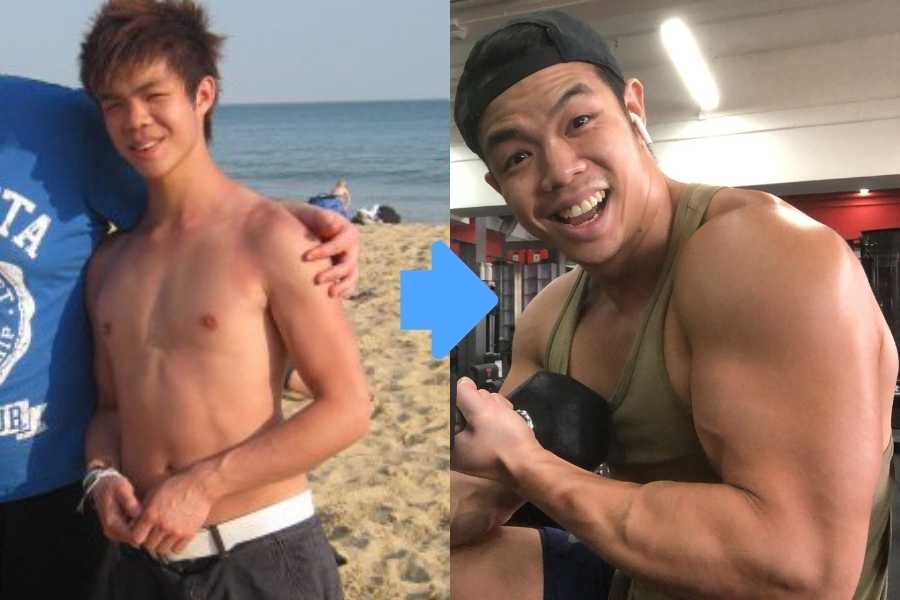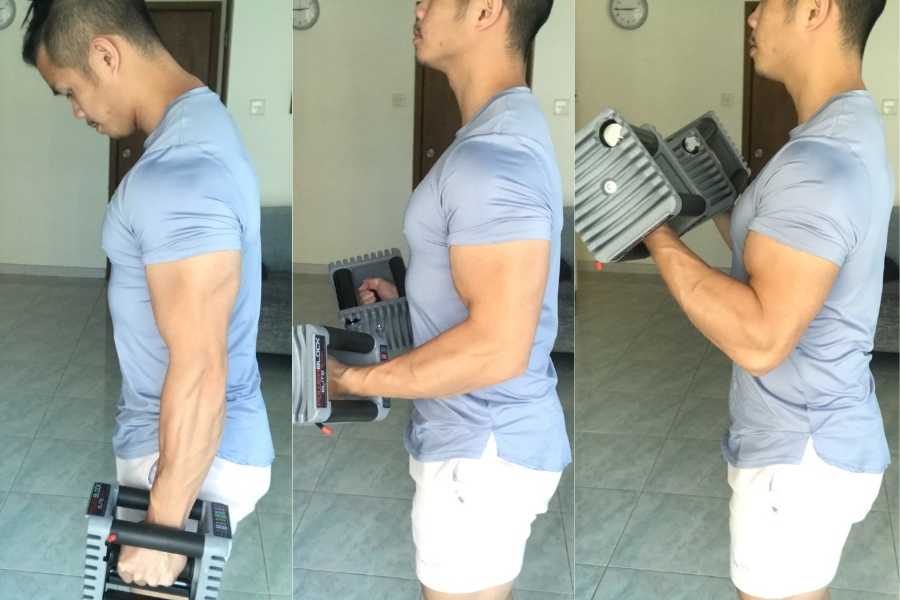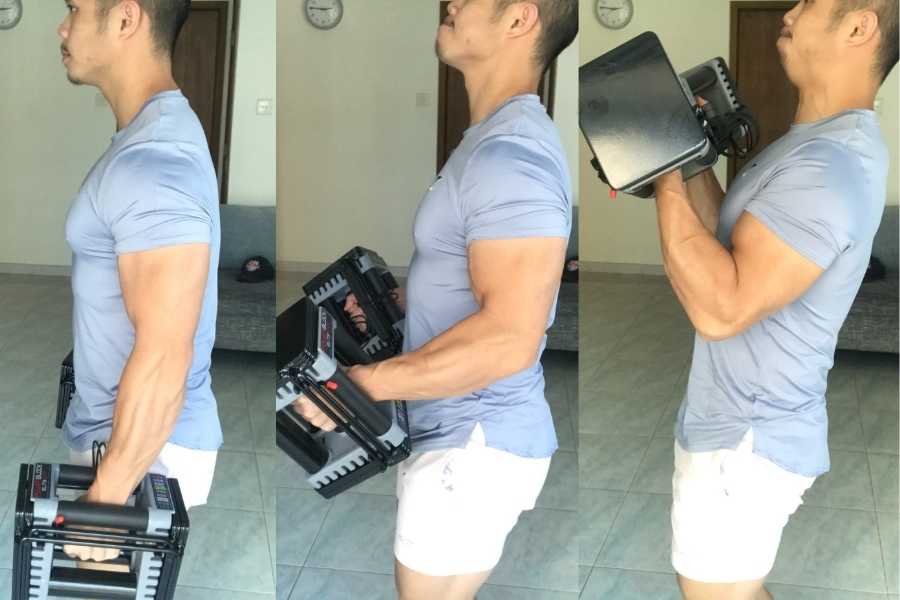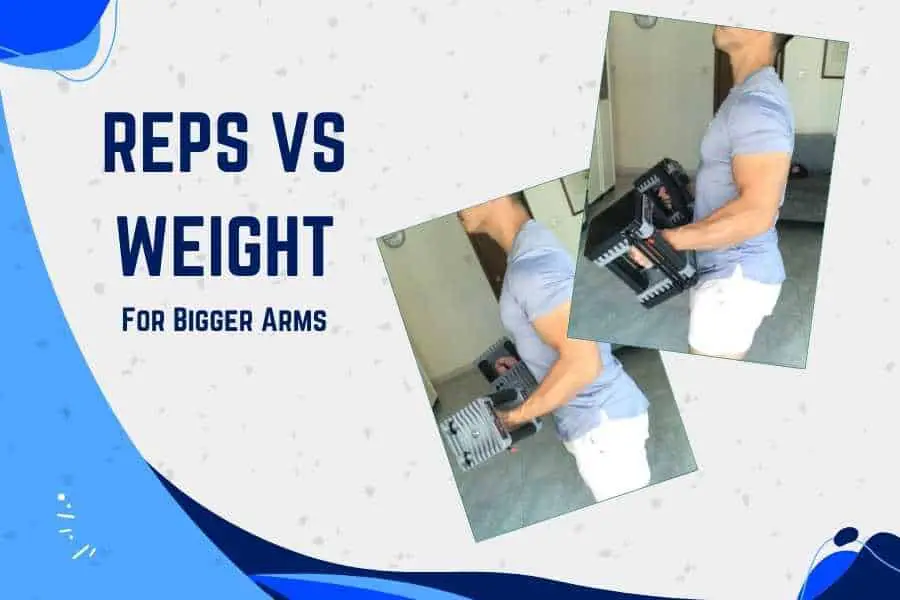Many people dream of building bigger, stronger, and more defined arm muscles. But choosing the correct rep range to train your biceps and triceps can be confusing. Is there even a “right” number of reps for optimal growth? This post discusses the age-old question: are high vs low reps better for bigger arms?
High and low reps can both increase arm size. Lifting in a higher rep range (15+) emphasizes time under tension and metabolic stress, whereas a lower range (5-8) places greater focus on mechanical tension. All three stimuli promote hypertrophy in the biceps and triceps.
Below, I examine the pros and cons of using both rep ranges and explain why a moderate rep range can give you the best of both worlds. Make sure you check out the combination method which helped me to explode my guns!

- Difference Between Lifting For Reps Vs Weight
- Why Low Reps Heavy Weight And High Reps Light Weight Can Build Bigger Arms
- Benefits & Drawbacks Of Using A High Rep Range For Arms
- Benefits & Drawbacks Of Using A Low Rep Range For Arms
- Do The Biceps/Triceps Respond Better To High Or Low Reps?
- Combination Method To Explode Your Biceps And Triceps
- Conclusion
Difference Between Lifting For Reps Vs Weight
First, let’s define what is generally meant by a high, low, and moderate rep range:
“High reps typically mean 15-20 per set; low reps are usually between 2-6 per set; and moderate reps are 8-12 per set.”
Elliot Reimers, M.S.(C), CISSN, CNC.
Your chosen rep range in turn affects how much weight you should lift, as follows:
| Rep Range | Weight | Percentage Of 1RM |
|---|---|---|
| High | Light | 60-70% |
| Moderate | Medium | 70-80% |
| Low | Heavy | 80-95% |
1 RM = 1-rep max.
Furthermore, different rep ranges are ideal for different objectives, as follows:
| Recommended Rep Range | Primary Training Goal |
|---|---|
| High reps using a light weight | Build bigger biceps and triceps size |
| Low reps using a heavy weight | Increase biceps and triceps strength |
| Moderate reps using a medium weight. | Both of the above |
Next, I’ll explain how low and high-rep ranges can both be effective for driving arm muscle growth.
Why Low Reps Heavy Weight And High Reps Light Weight Can Build Bigger Arms
Speaking from personal experience, it’s completely possible to grow your biceps and triceps using both high- and low-rep training.
In support of this, a 2015 study found that lifting light loads (high-rep) and heavy loads (low-rep) can both elicit significant gains in muscle size when performed to failure.
To understand why this happens, you need to know the 3 main types of stimuli that drive muscle growth (hypertrophy):
- Mechanical tension. The amount of weight being lifted. The heavier the load, the greater the mechanical tension, and the stronger the hypertrophy signal.
- Time under tension (TUT). The total time a muscle spends contracting in a given set. The higher the reps, the higher the TUT, and the stronger the hypertrophy signal.
- Metabolic stress. This refers to the waste products produced by muscle cells in response to intense activity like weight training. Metabolic waste is known to be anabolic (muscle-building). The higher the reps, the greater the metabolic stress.
Additionally, all three stimuli can simultaneously drive hypertrophy and strength (but to different degrees). Mechanical tension is great for emphasizing strength gains. In comparison, time under tension and metabolic stress are great for eliciting hypertrophy.

In other words, strength and hypertrophy are not mutually exclusive. Rather, strength gains usually come with hypertrophy (and vice versa). And this is why lifting high reps (using a low weight) and low reps (using a high weight) can both help you build bigger arms.
With that being said, there are certain situations where you may prefer to adopt one rep range over the other in your workout program (see next).
There are many common mistakes that beginners make when it comes to training arms. Check out my other post to find out how to grow bigger arms fast!
Benefits & Drawbacks Of Using A High Rep Range For Arms
| Benefits | Drawbacks |
|---|---|
| Greater time under tension, metabolic stress, and arm hypertrophy. | Reduced mechanical tension and strength gains. |
| Increased peak muscle contraction and range of movement. | Places a greater emphasis on cardiovascular demand which can negatively impact hypertrophy. |
Benefits Explained:
- Greater time under tension and metabolic stress stimuli. As mentioned previously, these are two powerful stimuli for hypertrophy. This is why bodybuilders commonly work in the high-rep range for smaller muscle groups like the biceps and triceps to get the so-called “pump”.
- Increased muscle contraction and range of movement (ROM). Lifting a lighter weight for more reps allows you to perform an exercise with the best form possible. This in turn leads to greater muscle activation and hypertrophy response.
Drawbacks Explained:
- Reduced mechanical tension stimuli. You invariably have to reduce weight in order to lift more reps. And this reduces mechanical tension stimuli. As a result, biceps and triceps strength gains will be sub-optimal. This in turn may negatively impact your capability to apply progressive overload (increasing weight over time), which is the bread and butter for skinny beginners looking to get big.
- Emphasis on cardiovascular demand. High reps place a greater cardio demand on your body. And if your cardio fitness is not great, then you may find your cardiovascular system giving in before your biceps and triceps truly reach muscular fatigue. This can negatively impact hypertrophy since your arms aren’t being worked to failure.
Ideal Way To Use This Rep Range:
Doing high reps using a low weight is ideal for isolation-type exercises like the dumbbell curl and overhead tricep extension. It allows you to lift through the full ROM, maximize peak muscle activation, and get a good pump to define your arms.

Generally speaking, I would not recommend high reps for compound-type arm exercises like the barbell row and bench press. The main focus of these movements is usually to lift heavy and apply progressive overload (especially for people looking to get big). Most beginners can’t do this efficiently using high reps.
Another instance where high reps work really well is if you already have a strength foundation. In this case, your muscles are likely already at a good size. Now you can use high-rep workouts to further increase the definition and tone in your arms. This is a popular tactic among bodybuilders.
Benefits & Drawbacks Of Using A Low Rep Range For Arms
| Benefits | Drawbacks |
|---|---|
| Greater mechanical tension, fast-twitch muscle fiber activation, and arm strength gains. | Reduced time under tension, metabolic stress, and arm hypertrophy. |
| Increased capability for progressive overload. | Can promote bad lifting form, reduced ROM, and cheat lifting in beginners. |
Benefits Explained:
- Greater mechanical tension stimuli. Lifting heavy loads at low reps is the best way to stimulate the fast-twitch muscle fibers in your biceps and triceps. Unlike their slow-twitch counterparts, fast-twitch fibers are more responsive to growth. This explains why lifters often live by the mantra, “lift big to get big”.
- Facilitates progressive overload. Low-rep ranges allow you to lift the heaviest weights possible in short but intense sets. This is conducive to rapid strength gains. And this in turn makes it easier to progressive overload (increasing weight over time to promote hypertrophy).
Drawbacks Explained:
- Reduced time under tension and metabolic stress stimuli. Working in a low-rep range means you won’t be able to perform as many reps per set, compared to working in a high-rep range. This leads to a less prominent “muscle pump”. However, the positive tradeoff is that lifting heavy for low reps is great for progressive overload which in turn benefits overall bicep/tricep-building.
- Bad lifting form, reduced ROM, and cheat lifting. This has the biggest negative impact on newbie lifters who are still learning how to lift with good form. Here, lifting too heavy a weight can promote cheat reps which are generally not ideal for optimal biceps and triceps growth. You can go to my other posts to find out how much weight you should be lifting for dumbbell curls and tricep extensions.
Ideal Way To Use This Rep Range:

The most obvious way to utilize a low-rep range for your biceps and triceps is to simply lift heavy for ~5 reps per set using isolation-type movements like curls and extensions. Bodybuilders sometimes do this intermittently to make strength gains in the arms.
The second way to utilize low reps for your arms is to lift heavy for ~5 reps per set using compound-type arm exercises like rows and bench presses. These movements work your biceps and triceps indirectly. And when performed under heavy loads, they’re great for promoting arm growth.
Do The Biceps/Triceps Respond Better To High Or Low Reps?

Now for the million-dollar question: are your arms more responsive to a high- or low-rep range?
The answer is they can both be equally effective when applied properly (as discussed above). The important point to take home is that different rep ranges offer different types of stimuli (mechanical tension, time under tension, and metabolic stress). And all three stimuli can drive muscle growth.
This is why the most common approach for working arms is to simply work in a moderate-rep range of 8-12 reps per set. You get the best of both worlds (balanced hypertrophy and strength gains).
In support, this 2016 study showed that lifting in a moderate-rep range led to the biggest increase in biceps and triceps thickness, compared to low- and high-rep ranges.
Another alternative is to combine low-, moderate-, and high-rep training into a well-structured arm program (see the combination method next).
Combination Method To Explode Your Biceps And Triceps
Taking everything into consideration- here’s how I train my bi’s and tri’s using a combination approach. The program can be applied to all arm exercises like curls, extensions, and their variations. This method will work your arms across all rep ranges.
| Month | Reps Per Set | Recommended Weight |
|---|---|---|
| 1-2 | 6 | 85% of 1RM |
| 3-4 | 10 | 75% of 1RM |
| 5-6 | 15 | 65% of 1RM |
Mini-cycle = 2 months. Macro-cycle = 6 months.
Overview
The program revolves around the periodization principle: purposely manipulating your rep range across multiple mini-cycles as part of a macro-cycle.
The idea is to focus on a specified rep range for each 2-month mini-cycle and apply progressive overload throughout. This way, your arms are constantly challenged with new types of stimuli and you gain the benefits from all rep-ranges.
Once you’ve completed all 3 mini-cycles, you’ve completed the 6-month macro-cycle. Now rinse and repeat.
This principle can be applied to all of your isolation-type arm exercises.
Months 1-2
Focus on performing your exercises with 6 reps per set. Ensure that the chosen weight is heavy enough to fatigue your arms within the 6 reps but light enough to maintain good lifting form. This usually equates to ~85% of 1RM for most people.
Apply progressive overload by adding 2.5lbs per week if you’re able to complete your current reps with good form. For example, if you can complete 6 good reps of bicep curls using 10lb dumbbells this week, then use 12.5lb dumbbells the following week.
Months 3-4
The second mini-cycle switches to a moderate 10-rep range. Again, make sure you use a suitable amount of weight. I recommend decreasing to ~75% of your 1RM when working with 10 reps.
Again, apply regular progressive overload throughout these 2 months. For example, if you can complete 10 reps of tricep extensions with good form using 7.5lb dumbbells this week, then switch to 10lb dumbbells the following week.
Months 5-6
The third and final mini-cycle increases to a high 15-rep range. As always, lift a suitable weight with good form. I recommend dropping to ~65% of your 1RM when working in the 15-rep range.
Progressive overload may be slightly harder in this high-rep range. But you should still be able to increase weight every 2 weeks, assuming you’re following a good nutrition plan.
Ninja tip
I like to progressive overload by increasing TUT rather than adding weight when lifting in high-rep ranges. You can do this by reducing the tempo of each rep. For example, if a single bicep curl rep usually takes you 2 seconds to complete, then prolong this to 4 seconds by slowing down the rep. This is a great way to get your arms pumped!
Conclusion
There is no right or wrong answer when deciding between high vs low reps for building bigger arms. That’s because high and low rep ranges can both promote biceps and triceps growth if sufficient weight is being used.
The most important consideration is to use a load that fatigues your muscle and apply progressive overload.
With that being said, moderate-rep ranges (8-12 reps per set) are commonly used by many lifters to strike a good balance between strength and hypertrophy gains. This is what I recommend beginners to start with.
For lifters who have more experience, you can try my combination approach to work your arms across all rep ranges!
You may also be interested in the downloadable Kalibre Blueprint PDF which details exactly how I gained 40lbs of lean muscle (it’s 100% free!). It details the exact exercises and nutrition (with printables) I used to go from skinny to ripped!


